Protein phosphatase 3 differentially modulates vascular endothelial growth factor- and fibroblast growth factor 2-stimulated cell proliferation and signaling in ovine fetoplacental artery endothelial cells
- PMID: 18509162
- PMCID: PMC2574765
- DOI: 10.1095/biolreprod.108.068957
Protein phosphatase 3 differentially modulates vascular endothelial growth factor- and fibroblast growth factor 2-stimulated cell proliferation and signaling in ovine fetoplacental artery endothelial cells
Abstract
A critical process for vascular endothelial growth factor (VEGF)- and fibroblast growth factor 2 (FGF2)-regulated cellular function is reversible protein phosphorylation, which is tightly controlled by a balance of protein kinases and phosphatases. We have reported that in ovine fetoplacental artery endothelial (OFPAE) cells, VEGF and FGF2 stimulate cell proliferation in part via activation of mitogen-activated protein kinase kinase 1/2 (MAP2K1/2)/mitogen-activated protein kinase 3/1 (MAPK3/1) and phosphoinositide 3-kinase (PI3K)/v-akt murine thymoma viral oncogene homolog 1 (AKT1) pathways. In the present study, we examined if protein phosphatase 3 (PPP3) mediated VEGF- and FGF2-stimulated OFPAE cell proliferation via modulating activation of MAPK3/1 and AKT1. Small interfering RNA (siRNA) targeting human PPP3 catalytic subunit alpha (PPP3CA) was used to suppress PPP3CA protein expression in OFPAE cells. Compared with the scrambled siRNA, PPP3CA siRNA decreased PPP3CA protein levels by approximately 97% without altering protein levels of protein phosphatase 2 catalytic subunit alpha, total MAPK3/1, total AKT1, or glyceraldehyde-3-phosphate dehydrogenase. Knockdown of PPP3CA protein expression enhanced VEGF-stimulated, but not FGF2-stimulated, cell proliferation. Knockdown of PPP3CA protein expression did not significantly affect VEGF-induced MAPK3/1 and AKT1 phosphorylation but attenuated FGF2-induced MAPK3/1 and AKT1 phosphorylation. Thus, to our knowledge, the present study is the first to demonstrate successful knockdown of PPP3CA protein expression in any cell model using a single pair of double-strained siRNA. Moreover, specific knockdown of PPP3CA protein expression enhances VEGF-stimulated, but not FGF2-stimulated, OFPAE cell proliferation and attenuates FGF2-induced, but not VEGF-induced, MAPK3/1 and AKT1 activation. Thus, PPP3CA differentially modulates the VEGF- and FGF2-stimulated cell proliferation and signaling cascades in OFPAE cells. These data also suggest that signaling molecules other than MAPK3/1 and AKT1 play an important role in VEGF- and FGF2-stimulated cell proliferation after knockdown of PPP3CA in OFPAE cells.
Figures
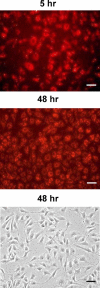
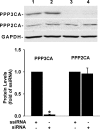
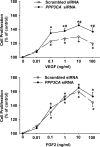
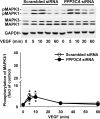
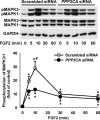
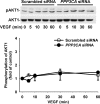
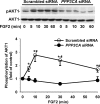
Similar articles
-
Hypoxia enhances FGF2- and VEGF-stimulated human placental artery endothelial cell proliferation: roles of MEK1/2/ERK1/2 and PI3K/AKT1 pathways.Placenta. 2009 Dec;30(12):1045-51. doi: 10.1016/j.placenta.2009.10.007. Epub 2009 Nov 5. Placenta. 2009. PMID: 19892399 Free PMC article.
-
Suppression of protein phosphatase 2 differentially modulates VEGF- and FGF2-induced signaling in ovine fetoplacental artery endothelial cells.Placenta. 2009 Oct;30(10):907-13. doi: 10.1016/j.placenta.2009.07.003. Epub 2009 Aug 18. Placenta. 2009. PMID: 19692121 Free PMC article.
-
Activation of multiple signaling pathways is critical for fibroblast growth factor 2- and vascular endothelial growth factor-stimulated ovine fetoplacental endothelial cell proliferation.Biol Reprod. 2008 Jan;78(1):143-50. doi: 10.1095/biolreprod.107.064477. Epub 2007 Sep 26. Biol Reprod. 2008. PMID: 17901071 Free PMC article.
-
Differential activation of multiple signalling pathways dictates eNOS upregulation by FGF2 but not VEGF in placental artery endothelial cells.Placenta. 2008 Aug;29(8):708-17. doi: 10.1016/j.placenta.2008.05.005. Epub 2008 Jun 20. Placenta. 2008. PMID: 18571718 Free PMC article.
-
Signaling regulation of fetoplacental angiogenesis.J Endocrinol. 2012 Mar;212(3):243-55. doi: 10.1530/JOE-11-0296. Epub 2011 Nov 21. J Endocrinol. 2012. PMID: 22106098 Free PMC article. Review.
Cited by
-
Deep Insight of the Pathophysiology of Gestational Diabetes Mellitus.Cells. 2022 Aug 28;11(17):2672. doi: 10.3390/cells11172672. Cells. 2022. PMID: 36078079 Free PMC article. Review.
-
Hypoxia enhances FGF2- and VEGF-stimulated human placental artery endothelial cell proliferation: roles of MEK1/2/ERK1/2 and PI3K/AKT1 pathways.Placenta. 2009 Dec;30(12):1045-51. doi: 10.1016/j.placenta.2009.10.007. Epub 2009 Nov 5. Placenta. 2009. PMID: 19892399 Free PMC article.
-
Expression and roles of Slit/Robo in human ovarian cancer.Histochem Cell Biol. 2011 May;135(5):475-85. doi: 10.1007/s00418-011-0806-2. Epub 2011 Apr 5. Histochem Cell Biol. 2011. PMID: 21465248 Free PMC article.
-
An endogenous aryl hydrocarbon receptor ligand inhibits proliferation and migration of human ovarian cancer cells.Cancer Lett. 2013 Oct 28;340(1):63-71. doi: 10.1016/j.canlet.2013.06.026. Epub 2013 Jul 9. Cancer Lett. 2013. PMID: 23851185 Free PMC article.
-
Rac1-dependent intracellular superoxide formation mediates vascular endothelial growth factor-induced placental angiogenesis in vitro.Endocrinology. 2010 Nov;151(11):5315-25. doi: 10.1210/en.2010-0178. Epub 2010 Sep 15. Endocrinology. 2010. PMID: 20844008 Free PMC article.
References
-
- Zygmunt M, Herr F, Munstedt K, Lang U, Liang OD. Angiogenesis and vasculogenesis in pregnancy. Eur J Obstet Gynecol Reprod Biol 2003; 110: S10 S18 - PubMed
-
- Reynolds LP, Borowicz PP, Vonnahme KA, Johnson ML, Grazul-Bilska AT, Wallace JM, Caton JS, Redmer DA. Animal models of placental angiogenesis. Placenta 2005; 26: 689 708 - PubMed
-
- Magness RR, Zheng J. Circulatory changes during gestation. Gluckman PD, Heymann MA. Scientific Basis of Pediatric and Perinatal Medicine. London: Edward Arnold Publishers; 1996: 762 772
-
- Ferrara N, Gerber HP, LeCouter J. The biology of VEGF and its receptors. Nat Med 2003; 9: 669 676 - PubMed
-
- Powers CJ, McLeskey SW, Wellstein A. Fibroblast growth factors, their receptors and signaling. Endocrine-Related Cancer 2000; 7: 165 197 - PubMed
Publication types
MeSH terms
Substances
Grants and funding
LinkOut - more resources
Full Text Sources
Research Materials
Miscellaneous

